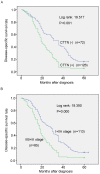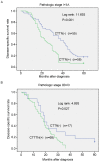Genome-wide gene expression profile analyses identify CTTN as a potential prognostic marker in esophageal cancer
- PMID: 24551190
- PMCID: PMC3925182
- DOI: 10.1371/journal.pone.0088918
Genome-wide gene expression profile analyses identify CTTN as a potential prognostic marker in esophageal cancer
Abstract
Aim: Esophageal squamous cell carcinoma (ESCC) is one of the most common fatal malignances of the digestive tract. Its prognosis is poor mainly due to the lack of reliable markers for early detection and prognostic prediction. Here we aim to identify the molecules involved in ESCC carcinogenesis and those as potential markers for prognosis and as new molecular therapeutic targets.
Methods: We performed genome-wide gene expression profile analyses of 10 primary ESCCs and their adjacent normal tissues by cDNA microarrays representing 47,000 transcripts and variants. Candidate genes were then validated by semi quantitative reverse transcription-PCR (RT-PCR), tissue microarrays (TMAs) and immunohistochemistry (IHC) staining.
Results: Using an arbitrary cutoff line of signal log ratio of ≥1.5 or ≤-1.5, we observed 549 up-regulated genes and 766 down-regulated genes in ESCCs compared with normal esophageal tissues. The functions of 302 differentially expressed genes were associated with cell metabolism, cell adhesion and immune response. Several candidate deregulated genes including four overexpressed (CTTN, DMRT2, MCM10 and SCYA26) and two underexpressed (HMGCS2 and SORBS2) were subsequently verified, which can be served as biomarkers for ESCC. Moreover, overexpression of cortactin (CTTN) was observed in 126/198 (63.6%) of ESCC cases and was significantly associated with lymph node metastasis (P = 0.000), pathologic stage (P = 0.000) and poor survival (P<0.001) of ESCC patients. Furthermore, a significant correlation between CTTN overexpression and shorter disease-specific survival rate was found in different subgroups of ESCC patient stratified by the pathologic stage (P<0.05).
Conclusion: Our data provide valuable information for establishing molecules as candidates for prognostic and/or as therapeutic targets.
Conflict of interest statement
Figures



Similar articles
-
Profiling of differentially expressed cancer-related genes in esophageal squamous cell carcinoma (ESCC) using human cancer cDNA arrays: overexpression of oncogene MET correlates with tumor differentiation in ESCC.Clin Cancer Res. 2001 Nov;7(11):3519-25. Clin Cancer Res. 2001. PMID: 11705871
-
Reduced stratifin expression can serve as an independent prognostic factor for poor survival in patients with esophageal squamous cell carcinoma.Dig Dis Sci. 2010 Sep;55(9):2552-60. doi: 10.1007/s10620-009-1065-0. Epub 2010 Jan 27. Dig Dis Sci. 2010. PMID: 20108042
-
Connective tissue growth factor expression in precancerous lesions of human esophageal epithelium and prognostic significance in esophageal squamous cell carcinoma.Dis Esophagus. 2011 Jul;24(5):337-45. doi: 10.1111/j.1442-2050.2010.01147.x. Epub 2010 Dec 10. Dis Esophagus. 2011. PMID: 21143696
-
Tenascin-C, a Prognostic Determinant of Esophageal Squamous Cell Carcinoma.PLoS One. 2016 Jan 5;11(1):e0145807. doi: 10.1371/journal.pone.0145807. eCollection 2016. PLoS One. 2016. PMID: 26731558 Free PMC article.
-
A cancer-array approach elucidates the immune escape mechanism and defects in the DNA repair system in esophageal squamous cell carcinoma.Arch Iran Med. 2013 Aug;16(8):463-70. Arch Iran Med. 2013. PMID: 23906251
Cited by
-
Analysis of SYK Gene as a Prognostic Biomarker and Suggested Potential Bioactive Phytochemicals as an Alternative Therapeutic Option for Colorectal Cancer: An In-Silico Pharmaco-Informatics Investigation.J Pers Med. 2021 Sep 6;11(9):888. doi: 10.3390/jpm11090888. J Pers Med. 2021. PMID: 34575665 Free PMC article.
-
Prognostic gene expression profiling in esophageal cancer: a systematic review.Oncotarget. 2017 Jan 17;8(3):5566-5577. doi: 10.18632/oncotarget.13328. Oncotarget. 2017. PMID: 27852047 Free PMC article.
-
Heterogeneous genomic aberrations in esophageal squamous cell carcinoma: a review.Am J Transl Res. 2020 May 15;12(5):1553-1568. eCollection 2020. Am J Transl Res. 2020. PMID: 32509161 Free PMC article. Review.
-
Overexpression of MCM10 promotes cell proliferation and predicts poor prognosis in prostate cancer.Prostate. 2018 Dec;78(16):1299-1310. doi: 10.1002/pros.23703. Epub 2018 Aug 10. Prostate. 2018. PMID: 30095171 Free PMC article.
-
Prognostic biomarker study in patients with clinical stage I esophageal squamous cell carcinoma: JCOG0502-A1.Cancer Sci. 2022 Mar;113(3):1018-1027. doi: 10.1111/cas.15251. Epub 2022 Jan 10. Cancer Sci. 2022. PMID: 34962019 Free PMC article. Clinical Trial.
References
-
- Jemal A, Siegel R, Ward E, Hao Y, Xu J, et al. (2009) Cancer statistics,2009. CA Cancer J Clin 59: 225–249. - PubMed
-
- Shahbaz Sarwar CM, Luketich JD, Landreneau RJ, Abbas G (2010) Esophageal cancer: an update. Int J Surg 8: 417–422. - PubMed
-
- Portale G, Hagen JA, Peters JH, Chan LS, DeMeester SR, et al. (2006) Modern 5-year survival of resectable esophageal adenocarcinoma: single institution experience with 263 patients. J Am Coll Surg 202: 588–598. - PubMed
-
- Lambert R, Hainaut P (2007) The multidisciplinary management of gastrointestinal cancer Epidemiology of esophagogastric cancer. Best Pract Res Clin Gastroenterol 21: 921–945. - PubMed
Publication types
MeSH terms
Substances
LinkOut - more resources
Full Text Sources
Other Literature Sources
Medical
Molecular Biology Databases
Miscellaneous

